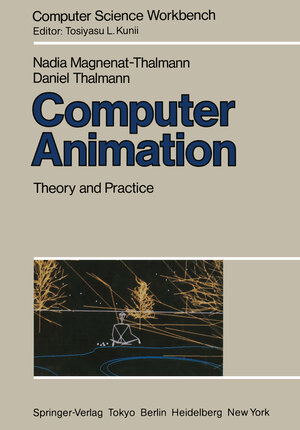
×
![Buchcover ISBN 9784431684336]()
Inhaltsverzeichnis
- 1. Introduction.
- 2. Conventional Animation.
- 2.1 Basic Principles of Conventional Animation.
- 2.2 How Are Cartoon Animated Films Made?.
- 2.3 Multiplane and Shooting Phase.
- 2.4 Some Techniques and Special Camera Effects.
- 2 5 Bar, Route, Model and Exposure Sheets.
- 2.6 Postproduction.
- 2 7 Historical Background.
- 2 8 Applications of Animation.
- 3. Computer Animation.
- 3 1 The Role of the Computer in Animation.
- 3.2 How to Classify Computer Animation Systems?.
- 3.3 Real-time vs. Frame-by-frame.
- 3.4 Frame Buffer Animation and Real-time Playback.
- 3 5 Systems vs. Languages.
- 4. The Development of Computer Animation in Various Organizations.
- 4.1 The Early Systems: BEFLIX and EXPLOR.
- 4.2 Picture-driven Animation: GENESYS.
- 4.3 Analog Systems· SCANIMATE and CAESAR.
- 4.4 ANIMATOR, ARTA and MOP.
- 4.5 Computer Animation at the National Research Council of Canada.
- 4.6 Computer Animation at Ohio State University.
- 4.7 From GRASS to ZGRASS.
- 4.8 New York Institute of Technology and Lucasfilm.
- 4.9 MAGI/Synthavision, Robert Abel, Triple I and Digital Effects.
- 4.10 And the Others?.
- 5. Key Frame and Painting Systems.
- 5.1 Computer-assisted Animation.
- 5.2 The Input of Drawings.
- 5.3 In-between Calculations.
- 5.4 The Laws of Animation.
- 5.5 Skeleton Techniques.
- 5.6 The Path of Motion and P-curves.
- 57 In-betweening Using Moving Point Constraints.
- 5.8 Coloring Techniques.
- 5.9 Paint Systems.
- 5.10 Color simulation and Dithering.
- 5.11 Gradation Techniques.
- 5.12 A Case Study: The Multiple Track Animator System.
- 6. Modeled Animation.
- 6.1 What Is Modeled Animation?.
- 6.2 Object Modeling.
- 6 3 Object Creation.
- 6.4 Motion Specification.
- 7. Hidden Surfaces, Reflectance and Shading.
- 7.1 Hidden Surfaces.
- 7.2 Light Reflection Models.
- 7 3 Shading.
- 7.4 Structured ShadedGraphical Types.
- 7.5 Rendering of Parametric and Patch Surfaces.
- 8. Transparency, Texture, Shadows and Anti-aliasing.
- 8.1 Ray-tracing Algorithms.
- 8 2 Transparency.
- 8.3 Texture.
- 8 4 Fractals.
- 8 5 Fuzzy Objects Modeling and Particle Systems.
- 8 6 Shadows.
- 8 7 Spatial Anti-aliasing.
- 8 8 Motion Blur and Temporal Anti-aliasing.
- 9. Human Modeling and Animation.
- 9.1 Stick, Surface and Volume Models.
- 9 2 The NUDES System.
- 9 3 The Badler Bubbleman.
- 9 4 Labanotation.
- 9.5 Hand Representation.
- 9.6 Facial Animation.
- 10. Object-oriented and Actor Languages and Systems.
- 10 1 Classes, Modules and Processes.
- 10 2 Kay’s Work and SMALLTALK.
- 10.3 Hewitt’s Actor Theory.
- 10.4 LOGO and the DIRECTOR Actor-based Animation Language.
- 10.5 ASAS· The Actor/Scriptor Animation System.
- 10.6 CINEMIRA: A Language Based on Actor and Camera Data Types.
- 10.7 MIRANIM· An Extensible Director-oriented 3D Animation System.
- 11. Case Studies.
- 11.1 Decor with Bridges and Houses.
- 11.2 Computer Animation of a Robotic Arm.
- 11.3 An Example of the Design of a Camera Path.
- 11.4 A Scene with a Shaded Corvette.
- 11.5 Fireworks.
- 12. A Case Study: Dream Flight.
- 12.1 Why Dream Flight?.
- 12.2 Scenario and Storyboard.
- 12.3 Decor Creation.
- 12.4 Actors and Dynamic Objects in the Forest.
- 12.5 Seascape.
- 12.6 Undersea Scene.
- 12.7 The Organization of a Scene and Shooting.
- References.
- Appendix A: Computer Animation Organizations and Teams.
- Appendix B: Computer Animation Systems and Languages.
- Appendix C: Computer-generated Films.


